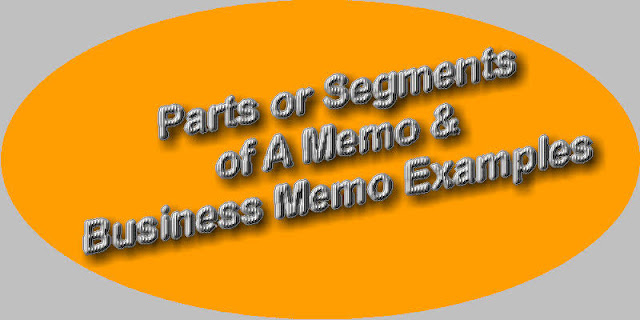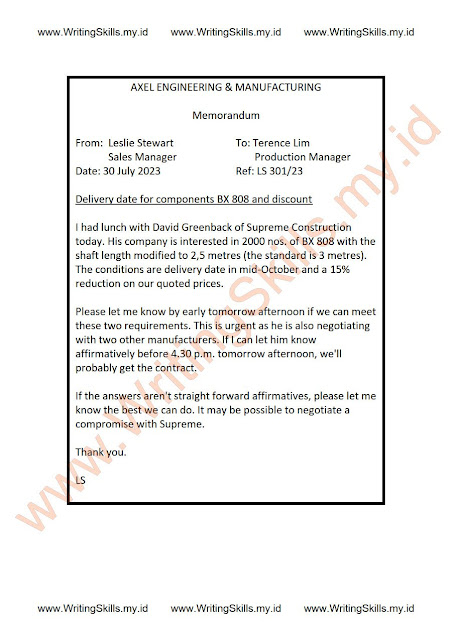WritingSkills.my.id - A standard memo is divided into several segments or parts to manage information and also to help the readers unde...
WritingSkills.my.id - A standard memo is divided into several segments
or parts to manage information and also to help the readers understand the
message that the writer wants to deliver.
Generally, there are 3 parts or segments of a memo:
- Heading Segment
- Content Segment
- Closing Segment
I will explain those 3 segments in the following explanations. Also check 4
samples of business memos after the explanations.
1. Heading Segment
General format of the heading segment is as follows:
| TO | : (The recipient's name and position) |
| FROM | : (The sender's name and position) |
| DATE | : (The complete date when the memo is made) |
| Ref / SUBJECT | : (The subject is bold) |
Tips on Creating Heading Segment:
- The memo recipient's name and his/her position must be written correctly because there might be numerous similar names. For formal memos, it is advised to write the full name of the recipient.
- A memo must have specific and concise subject. Avoid using words that have general meaning, for example the word "Rats" as the title or subject. The word "Rats" will have a very broad meaning that involves production activity, the company itself, or even relates to personal matters. The following subject would be more specific and clearer: "Curtailing Rat Extremity Parts in Our Product."
2. Content Segment
In general, the purpose of a memo delivered is written in the beginning of the
paragraph and consists of three parts: (1) Context and Problem; (2) Specific
Task; and (3) The Memo Purpose.
(1) Context and Problem
The context here are occasion, situation or background problem that must be
solved. The beginning of paragraph which is simple but easily understood is
like the example: "In our effort to reduce rat parts in our product..."
Remember that a memo only contains what is needed by the reader.
(2) Specific Task
In this part of specific task, a memo must explain what is wanted by the memo
sender to be done by the recipient to solve existing problems. If the
recipient is needed to act as soon as possible, the opening sentence could be
like the following example: "You are asked to..." If the sender want to
explain his purpose, it could be like the sentence below: "To determine the
best method of controlling the percentage of rat extremities, it will...."
(3) The Memo Purpose
In this memo purpose part, it could be stated the reason that the memo is sent
and things that must be done in the future. The sender must directly tell the
recipient about the information presented in the memo. For example, the sender
of the memo writes, "This memo presents a description of the current
situation, some proposed alternatives, and my recommendations."
The content of the memo must cover various detailed information that support
the initial idea. We must consider the following two things when creating a
memo:
- The most important information is placed in the beginning of the memo.
- The deductive method can be applied, that is presenting the general information first and then presenting the more specific information.
Tips On Creating Content Segment:
- It is better to use lists than to use paragraphs, so that the recipient will read the memo easily and his/her eyes will feel comfortable too.
- Make sure the lists use proper words that are correct in English grammar.
3. Closing Segment
This part is the last part of a memo. After the reader receives all the
information presented in the memo, he/she is expected to understand the act
that is wanted by the sender to be done. Take a look at this closing of a
memo:
|
I will be glad to discuss this recommendation with you during our Tuesday trip to the spa and follow through on any decisions you make." |
If it is needed, attachments like graph, table, list, and so on can be
included in the memo. At the end of the memo, mention that there are several
important attachments included. For example:
|
Attached: Several Complaints about Product, January - June 2023 |
4 Business Memo Examples, Samples
The following are four examples of memos for you as a guidance to start making
a well-written business memos.







COMMENTS